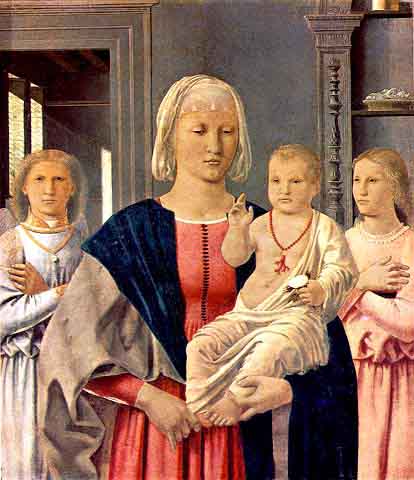Contents
Piero della Francesca
in Urbino, Sansepolcro, and Monterchi
Urbino, Galleria Nazionale delle Marche
|
Contents |
|
The Flagellation
c. 1455
Oil
and tempera on wood, 58.4 x 81.5 cm
Galleria Nazionale delle
Marche, Urbino
This panel painting - one of his most famous - was
executed during Piero's first visit to Urbino. It contains subtle
references to the situation of the time, which are difficult to
understand today. The theory that seems to be proposed most
frequently is that with the imminent Turkish attack on Constantinople
the painting was commissioned as a political support for the
reconciliation the Eastern and Western Churches. The character in the
center, in Greek dress possibly depicting the last Byzantine Emperor,
and an inscription on the frame ("convenerunt in unum")
support this interpretation.
From the point of view of composition and perspective the painting is rigorously planned. The composition is divided into two scenes, separated by a column supporting the temple in which the Flagellation of Christ is taking place. On the right are three figures, arranged in a semi-circle; their identity is not certain. They are probably well-known characters of the time and, as such, they would be portrayed with their real features. The importance of the architecture in this painting, with the elegant classical temple, would suggest that Piero was in touch with contemporary theoretical writings. The onlooker must stand directly in the centre of the painting, for the composition is strictly unitarian, achieved by a single vanishing point. The painting is the ultimate exemple of Quattrocento linear perspective.
Even though he is working in a unitary space, Piero does not give up his interest in detail, such as the ceiling of the temple or the bronze sculpture on the column with its splendid reflection of the light. The magnificent damask garment worn by the character on the far right, with its contrast between blue and gold, reveals Piero's love for luxurious clothing and for the most fashionable styles, which many Florentine painters had eliminated entirely from their work by that time.

Madonna of Senigallia
early
1470s,
Panel, 61 x 53,5 cm
Galleria Nazionale delle Marche,
Urbino
The painting, originally in the church of Santa Maria delle
Grazie in Urbino, is quite different from Piero's previous
production. The faces still have an expression of aloofness and of
superior rational wisdom, but they also convey a sense of precocious,
exotic beauty. This is one of the paintings in which the artist most
clearly reveals his interst in light values, both in terms of
reflections and of magical transparencies. From Mary's veil, slightly
puckered on her forehead with subtle light variations, to the coral
necklace around the Child's neck, to the angels' shining pearls -
these are all effects which, together with the light streaming in
from the window, and forming a perfectly geometrical shape on the end
wall, will appear again and again in Dutch painting of the 17th
century.
The Ideal City
c.
1470
Panel, 60 x 200 cm
Galleria Nazionale, Urbino
Twenty
years before his death Piero gradually stopped painting. One of the
reasons was his poor health and progressing blindness; another was
his growing interest in the theories behind the laws of perspective
and proportions which Piero devoted himself entirely to. In his
treatises "De Prospectiva pingendi" and "De Corporibus
regularibus" he analyzed the theoretical and scientific
foundations of his pictures. It is from his drawings in De
Prospectiva that the perspective construction of the so-called "Ideal
City" derives. If not by him this painting must have been
painted by a very close collaborator of his.
Museo Civico in Sansepolcro (1994)
In the minor municipal museum of Sansepolcro, Piero della Francesca's town of birth and death - 40 km north of Arezzo - hang two of his most famous paintings.
|
The Resurrection, 1463-65 |
Aldous Huxley once called this fresco from Piero's late years, which originally decorated one wall of the chamber of the Sansepolcro's civic hall next door, "the greatest painting in the world." It is a true fresco, its colors are muted and on first sight compared to the Arezzo frescoes disappointing, but the execution of the subject matter is uniquely Piero and full of subtle allusions, bare trees on one side, greening ones on the other, an imperial Christ climbing the ramparts of his grave....
|
St. Julian, 1455-60
|
|
Monterchi, Cemetery Chapel Polyptych of the Madonna della Misericordia, 1445-62 |
This polyptych was Piero's earliest known commission. The stiff and by the time old-fashioned assemblage was dictated by his patrons, the Society of Misericordia. A sturdy Madonna (Schutzmantelmadonna) protects the members of the association under her great coat.
|
Madonna del Parto, 1467 |
The Madonna del Parto, a pregnant Madonna is a very rare subject indeed in Italy. Located in the cemetery chapel of the village of Monticerchi, 20 km south of Arezzo, it was white-washed over for centuries until it was rediscovered in 1889. In very poor condition, it is one of Piero's last paintings and surly one of his most enigmatic.